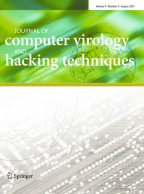Abstract
Vicious codes, especially viruses, as a kind of impressive malware have caused many disasters and continue to exploit more vulnerabilities. These codes are injected inside benign programs in order to abuse their hosts and ease their propagation. The offsets of injected virus codes are unknown and their targets usually are latent until they are executed and activated, what in turn makes viruses very hard to detect. In this paper enriched control flow graph miner, ECFGM in short, is presented to detect infected files corrupted by unknown viruses. ECFGM uses enriched control flow graph model to represent the benign and vicious codes. This model has more information than traditional control flow graph (CFG) by utilizing statistical information of dependent assembly instructions and API calls. To the best of our knowledge, the presented approach in this paper, for the first time, can recognize the offset of infected code of unknown viruses in the victim files. The main contributions of this paper are two folds: first, the presented model is able to detect unknown vicious code using ECFG model with reasonable complexity and desirable accuracy. Second, our approach is resistant against metamorphic viruses which utilize dead code insertion, variable renaming and instruction reordering methods.
Similar content being viewed by others
References
Aggarwal C., Wang H.: Managing and Mining Graph Data vol 40. Springer, New York (2010)
Anju, S., Harmya, P., Jagadeesh, N., Darsana, R.: Malware detection using assembly code and control flow graph optimization. In: Proceedings of the 1st Amrita ACM-W Celebration on Women in Computing in India, p. 65. ACM (2010)
Bayer U., Moser A., Kruegel C., Kirda E.: Dynamic analysis of malicious code. J. Comput. Virol. 2(1), 67–77 (2006)
Bilar D.: On callgraphs and generative mechanisms. J. Comput. Virol. 3(4), 285–297 (2007)
Bruschi, D., Martignoni, L., Monga, M.: Detecting self-mutating malware using control-flow graph matching. Detection of Intrusions and Malware & Vulnerability Assessment pp. 129–143 (2006)
Harley D.: Making sense of anti-malware comparative testing. Inf. Secur. Tech. Rep. 14(1), 7–15 (2009)
Hofmeyr S., Forrest S., Somayaji A.: Intrusion detection using sequences of system calls. J. Comput. Secur. 6(3), 151–180 (1998)
Idika N., Mathur A.: A survey of malware detection techniques, pp. 48. Purdue University, USA (2007)
Kostakis, O., Kinable, J., Mahmoudi, H., Mustonen, K.: Improved call graph comparison using simulated annealing. In: Proceedings of the 2011 ACM Symposium on Applied Computing, pp. 1516–1523. ACM (2011)
Lai, Y.: A feature selection for malicious detection. In: Software Engineering, Artificial Intelligence, Networking, and Parallel/Distributed Computing, 2008. SNPD’08. Ninth ACIS International Conference on, pp. 365–370. IEEE (2008)
Menahem E., Shabtai A., Rokach L., Elovici Y.: Improving malware detection by applying multi-inducer ensemble. Comput. Stat. Data Anal. 53(4), 1483–1494 (2009)
Moser, A., Kruegel, C., Kirda, E.: Limits of static analysis for malware detection. In: Computer Security Applications Conference, 2007. ACSAC 2007. Twenty-Third Annual, pp. 421–430. IEEE (2007)
PE-Explorer:(2011) http://www.pe-explorer.com/peexplorer-tour-disassembler.htm
Perdisci R., Lanzi A., Lee W.: Classification of packed executables for accurate computer virus detection. Pattern Recognit. Lett. 29(14), 1941–1946 (2008)
Picard, R., Cook, R.: Cross-validation of regression models. Journal of the American Statistical Association pp. 575–583(1984)
Shankarapani M., Ramamoorthy S., Movva R., Mukkamala S.: Malware detection using assembly and api call sequences. J. Comput. Virol. 7(2), 107–119 (2011)
Sulaiman, A., Ramamoorthy, K., Mukkamala, S., Sung, A.: Malware examiner using disassembled code (medic). In: Information Assurance Workshop, 2005. IAW’05. Proceedings from the Sixth Annual IEEE SMC, pp. 428–429. IEEE (2005)
Szor P.: The Art of Computer Virus Research and Defense. Addison-Wesley Professional, (2005)
Tesauro G., Kephart J., Sorkin G.: Neural networks for computer virus recognition. IEEE expert 11(4), 5–6 (1996)
Tong, W., Jin, R.: Semi-supervised learning by mixed label propagation. In: Proceedings of the National Conference on Artificial Intelligence, vol. 22, p. 651. AAAI Press, Menlo Park, MIT Press, London 1999 (2007)
Vinod, P., Laxmi, V., Gaur, M., Kumar, G., Chundawat, Y.: Static CFG Analyzer for Metamorphic Malware Code. In: Proceedings of the 2nd International Conference on Security of Information and Networks, pp. 225–228. ACM (2009)
Wang, J., Deng, P., Fan, Y., Jaw, L., Liu, Y.: Virus detection using data mining techinques. In: Security Technology, 2003. In: Proceedings. IEEE 37th Annual 2003 International Carnahan Conference. pp. 71–76. IEEE (2003)
Wespi, A., Dacier, M., Debar, H.: Intrusion detection using variable-length audit trail patterns. In: Recent advances in intrusion detection, pp. 110–129. Springer (2000)
You, I., Yim, K.: Malware obfuscation techniques: A brief survey. In: Broadband, Wireless Computing, Communication and Applications (BWCCA), 2010 International Conference on, pp. 297–300. IEEE (2010)
Zaidan A., Zaidan B., Othman F.: New technique of hidden data in pe-file with in unused area one. Int. J. Comput. Electr. Eng. (IJCEE) 1(5), 669–678 (2009)
Zhang, B., Yin, J., Hao, J., Wang, S., Zhang, D.: New malicious code detection based on n-gram analysis and rough set theory. Computational Intelligence and Security pp. 626–633 (2007)
Zolkipli, M., Jantan, A.: A framework for malware detection using combination technique and signature generation. In: Computer Research and Development, 2010 Second International Conference on, pp. 196–199. IEEE (2010)
Zuo Z., Zhou M.: Some further theoretical results about computer viruses. Comput. J. 47(6), 627–633 (2004)
Zuo Z., Zhu Q., Zhou M.: On the time complexity of computer viruses. IEEE Trans. Inf. Theory 51(8), 2962–2966 (2005)
Author information
Authors and Affiliations
Corresponding author
Rights and permissions
About this article
Cite this article
Eskandari, M., Hashemi, S. ECFGM: enriched control flow graph miner for unknown vicious infected code detection. J Comput Virol 8, 99–108 (2012). https://doi.org/10.1007/s11416-012-0169-9
Received:
Accepted:
Published:
Issue Date:
DOI: https://doi.org/10.1007/s11416-012-0169-9
